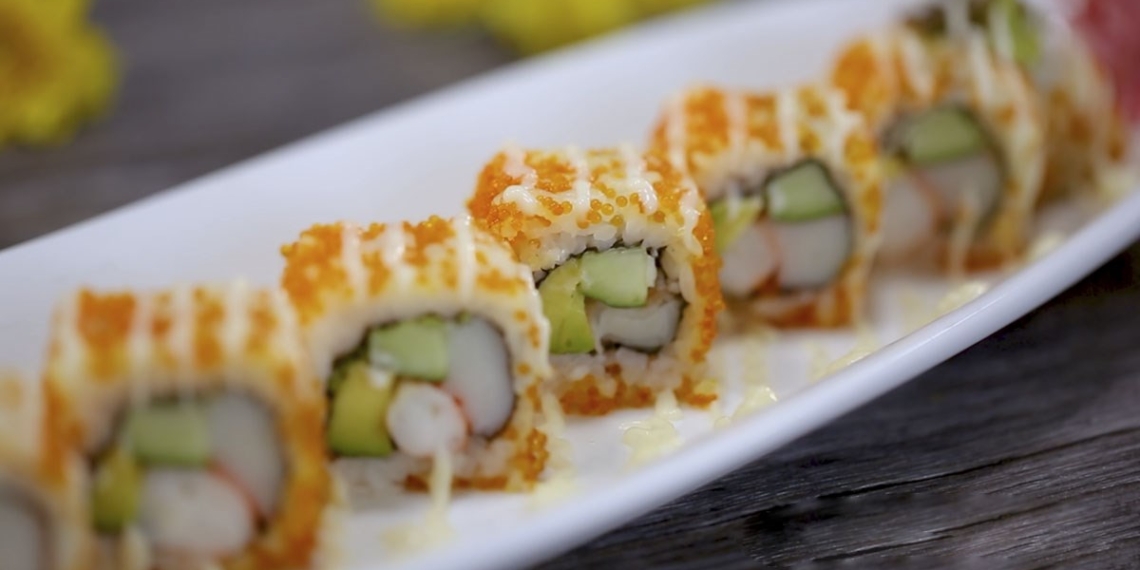-
Preparation
30 minutes
-
Cooking
40 minutes
-
Difficulty
Medium
Ingredients for Maki sushi For 2 people
Shrimp 40 gr Imitation crab 30 gr Fish roe 40 gr Hot rice 300 gr (cooked from Japanese rice) Avocado 1/2 fruit Cucumber 1 piece Seaweed 2 sheets Lettuce 30 gr Salt 5 teaspoons Sugar 2.5 tablespoons Vinegar 90 ml Cooking oil 2 teaspoons Mayonnaise 20 gr White wine 1 tablespoon
How to choose fresh ingredients
How to choose fresh shrimp
- When choosing shrimp, you should select those that are fresh with a transparent shell, still having a hint of sea smell, not fishy or unusually foul, and avoid shrimp with dark spots or inconsistent colors, bruised, or slimy.
- Choose shrimp with a slightly curved body, firm flesh but not unusually fat, the shell joints on the shrimp body should be flexible, not disjointed, the head and body of the shrimp should be tightly attached to each other, the head should not fall off from the body.
- Fresh shrimp usually have their tails folded together. If the shrimp’s tail is spread out, it means the shrimp has been injected with chemicals or water to make them look plumper.
How to choose fresh, crispy cucumbers
- Select cucumbers that are bright green, evenly colored, without bruises or yellow spots.
- Cucumbers that are elongated with uniform sizes are the type with thicker flesh, which will taste crisper than shorter, round cucumbers.
- It is advisable to choose heavier cucumbers with smooth skin, without blemishes, and it is better to select smaller cucumbers as they tend to be sweeter than larger ones.
- Avoid purchasing cucumbers that are bulging, larger in the middle, or with a big head and a small tail (and vice versa) as these are overripe cucumbers, with many seeds, hard, and not tasty.
Note when choosing ready-made ingredients
- Imitation crab sticks and flying fish roe can be found at large seafood markets or in reputable supermarkets and stores.
- If choosing packaged products, you should carefully check the expiration date, ensure the outer packaging is intact, not torn or discolored, and that the product inside shows no mold, bruises, or unusual leaking.
- If you can’t find flying fish roe, you can substitute it with roasted black sesame or roasted white sesame seeds.
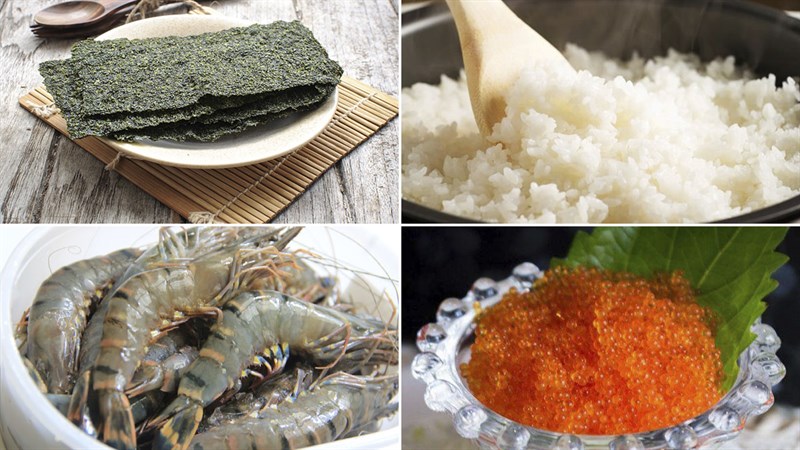
Tools needed:
Bamboo mat, plastic wrap, bowl,…
How to make Maki sushi
-
Prepare the ingredients
Shrimp should be soaked in water mixed with 2 teaspoons of salt and 1 tablespoon of white wine for about 10 minutes, then rinse briefly with water and let drain.
Use a skewer to pierce straight through the shrimp from tail to head to keep it straight.
Put a pot of water on the stove and bring it to a boil, then add 1 teaspoon of salt and 2 teaspoons of cooking oil to the pot and stir well. Next, add the shrimp and boil for about 3 – 5 minutes, then remove the shrimp and place it in a bowl of ice water for about 5 minutes, then remove the skewer and peel the shrimp.
Tip:
- Piercing the shrimp with a skewer helps keep it straight, making it easier to roll sushi.
- Adding cooking oil to the boiling water helps the shrimp become shiny and more visually appealing after boiling.
When you buy crab sticks, clean them thoroughly with water several times or briefly blanch them in boiling water to remove dirt, then let them drain.
Cut the avocado in half, separate the flesh, and then slice it thinly into strips about 15cm long.
Pick young lettuce leaves and soak them in salt water for about 15 minutes, then rinse thoroughly and let them drain.
Remove the seeds from the cucumber and slice it thinly into strips 15cm long.
Tip for preparing cucumber to avoid bitterness
- Cut off both ends of the cucumber and rub the ends vigorously in a circular motion until a layer of white foam appears. Remove this white foam, and the bitterness in the cucumber will be gone.
- Cut the cucumber in half lengthwise. Sprinkle a little salt on the cut side of each half and rub them together until white foam appears. Then rinse the cucumber with water.
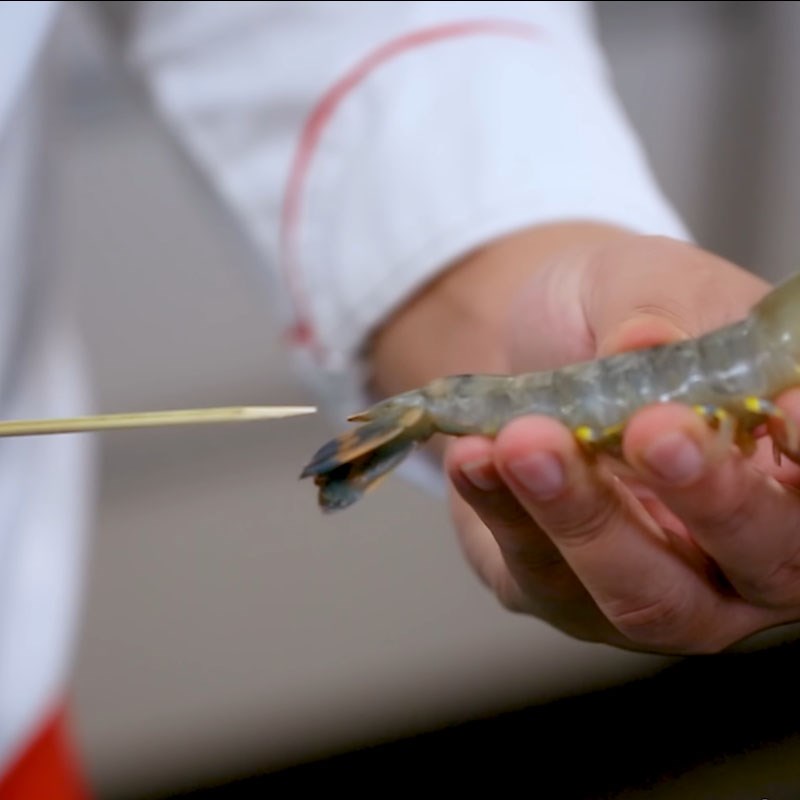
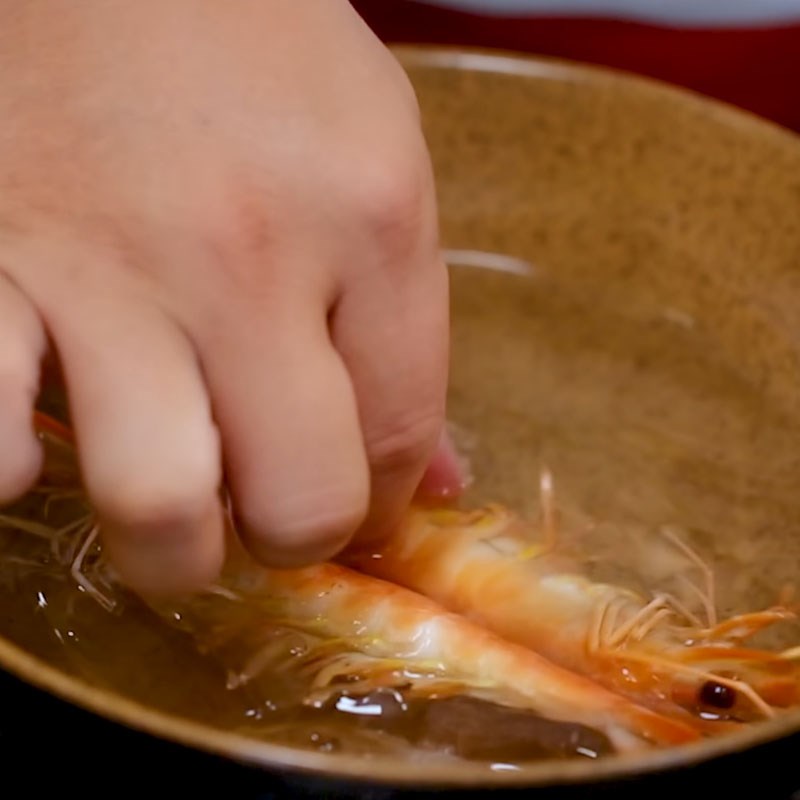
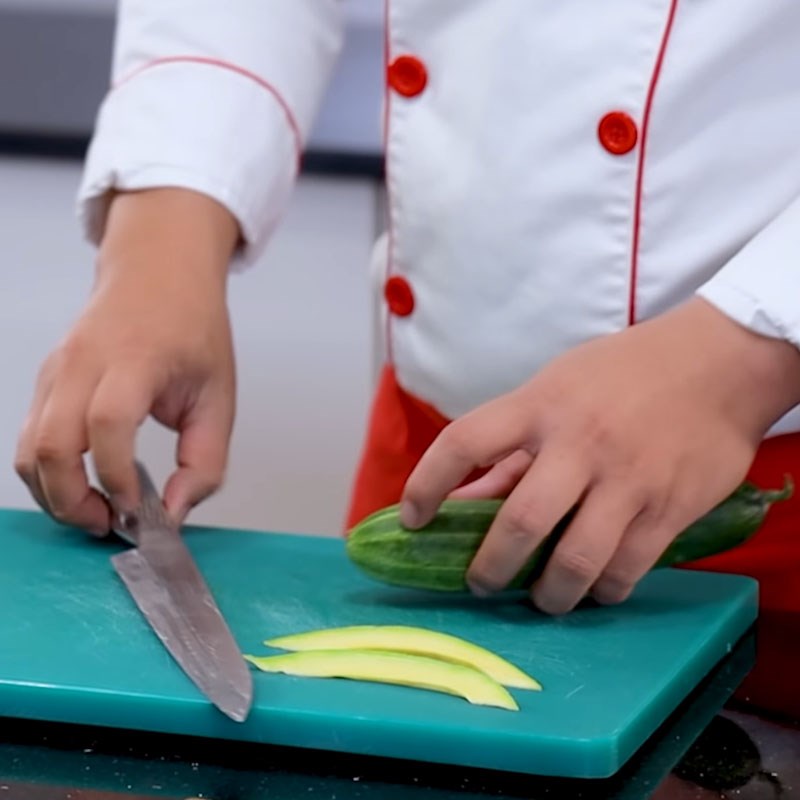

-
Make the vinegar sauce and mix
Place a pot on the stove, add 2 teaspoons of salt, 2.5 tablespoons of sugar, and 90ml of vinegar to the pot, turn on the heat, and stir the mixture until the salt and sugar are completely dissolved, then turn off the heat.
Small tip: You should only heat until the sugar and salt are completely dissolved; the mixture should be warm, not boiling, because if it boils, the vinegar will evaporate and lose its flavor.
300g of rice after cooking, you put it into a bowl, measure 60ml of the vinegar sauce mixture just cooked and drizzle it slowly over the rice, then mix thoroughly to ensure the rice is fluffy and evenly absorbs the vinegar sauce.
Tip:
- It is recommended to mix the rice while it is still hot so that the vinegar penetrates evenly into the rice.
- When mixing, just gently stir; avoid strong pressing as it will cause the rice grains to break.
- The leftover vinegar sauce can be stored in a tightly sealed glass jar and kept in the refrigerator.
- The appropriate ratio of vinegar and rice for sushi dishes is 1kg of rice – 200ml of vinegar sauce; you can adjust the amount according to the above ratio.
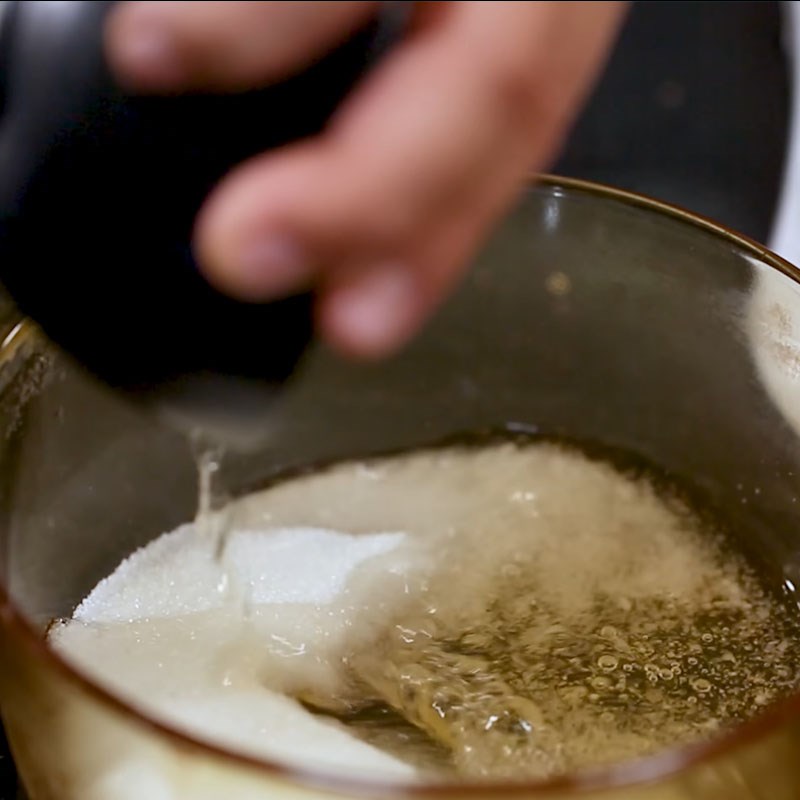
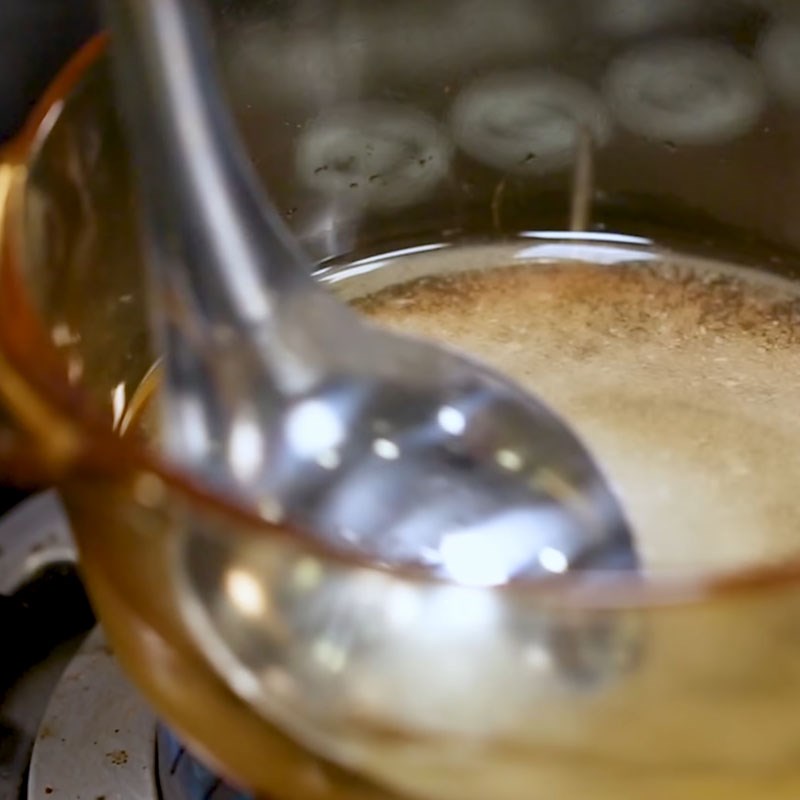
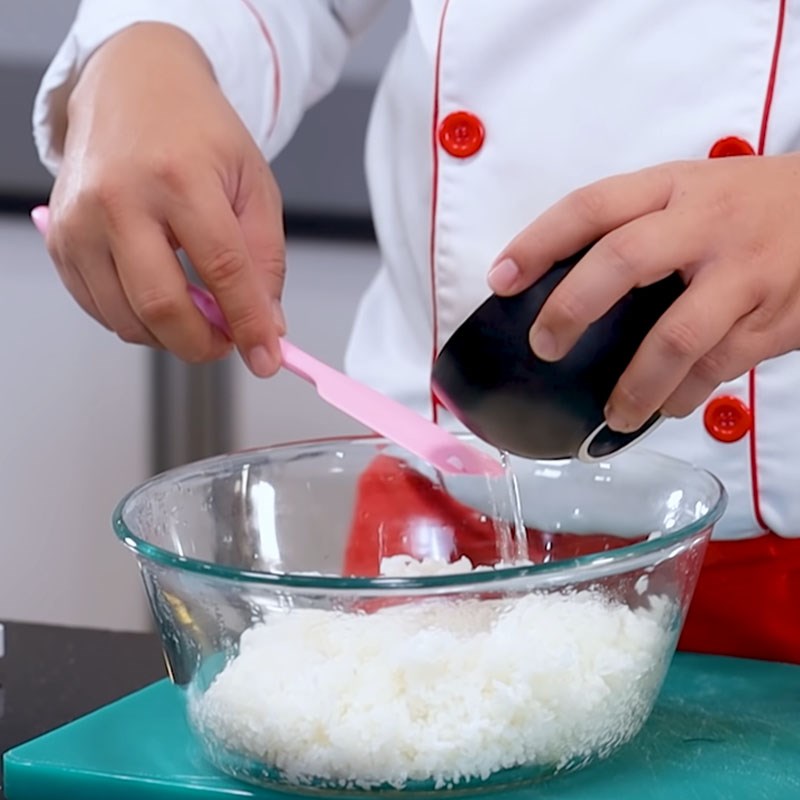
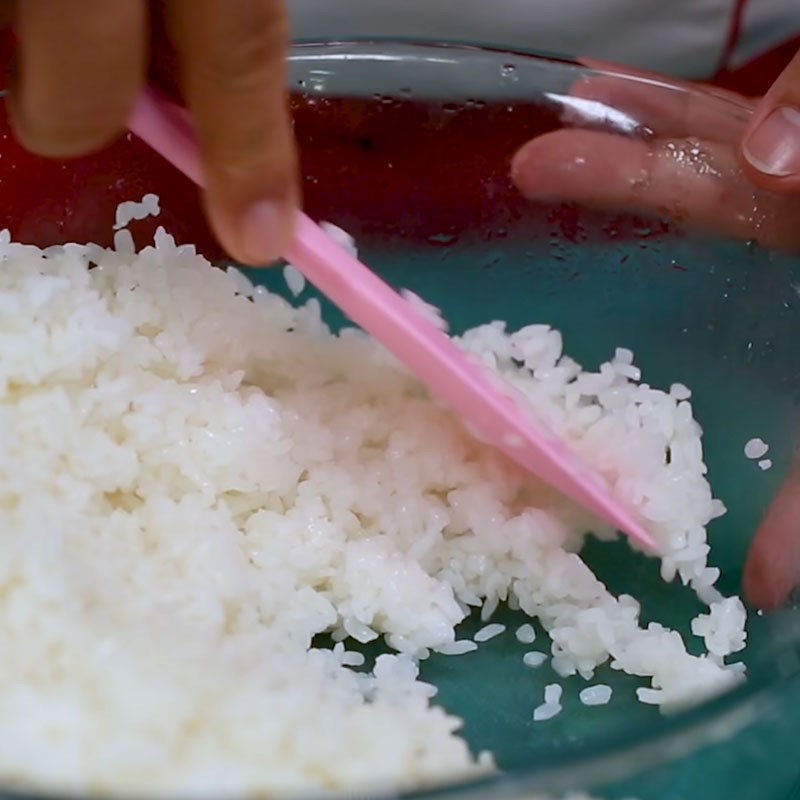
-
Proceed to roll the rice
Lay a bamboo mat covered with a layer of cling film on the table, then gently place a sheet of seaweed at the top edge of the mat.
Tip: Lining the bamboo mat with cling film helps prevent the rice from sticking to the mat when rolling and makes the sushi firmer and easier to cut after rolling.
Moisten a bit of water and spread it evenly over both palms, then take about 70 – 80 grams of rice and spread it evenly on the seaweed sheet so that the rice protrudes about 1cm beyond the seaweed.
Next, add 40 grams of flying fish roe on top of the rice and spread it evenly across the surface of the rice.
Fold the edges of the bamboo mat up over the rice, then flip the mat over so that the rice and fish roe are facing down as illustrated below.
Next, place the lettuce and drizzle a bit of mayonnaise sauce on top in the horizontal direction of the seaweed sheet.
Continue to layer cucumber, avocado, crab stick, and shrimp in the horizontal direction of the seaweed sheet.
Use four fingers to hold the filling in place, then hold the edge of the bamboo mat and roll it tightly. After completing one full turn, press it tightly and evenly to create a round roll for the sushi and release it.
Then, continue to use the bamboo stick to roll it one more time, pressing it tightly and evenly until the seaweed is completely rolled up.
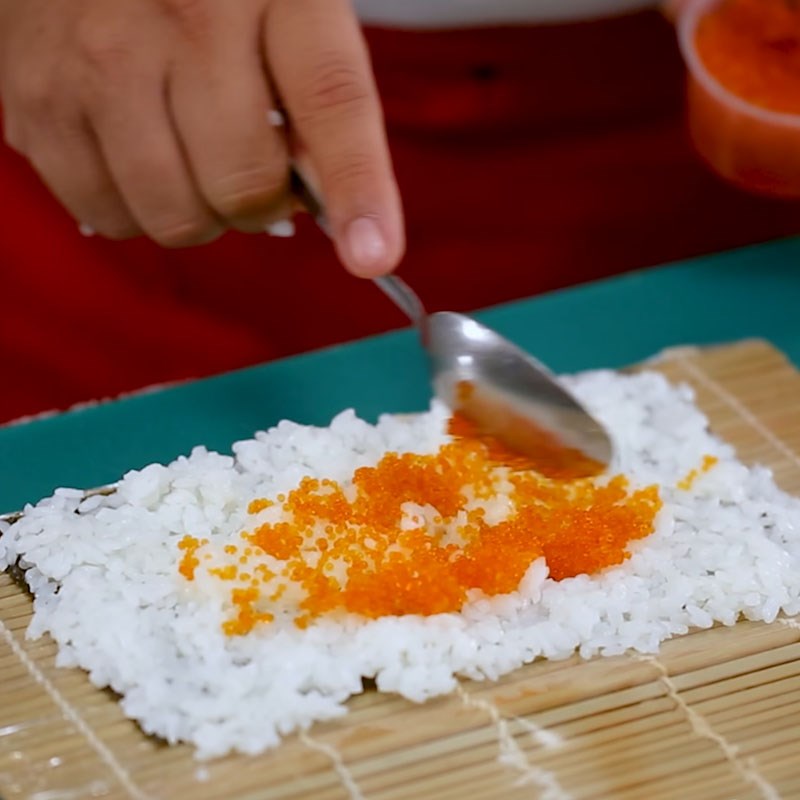
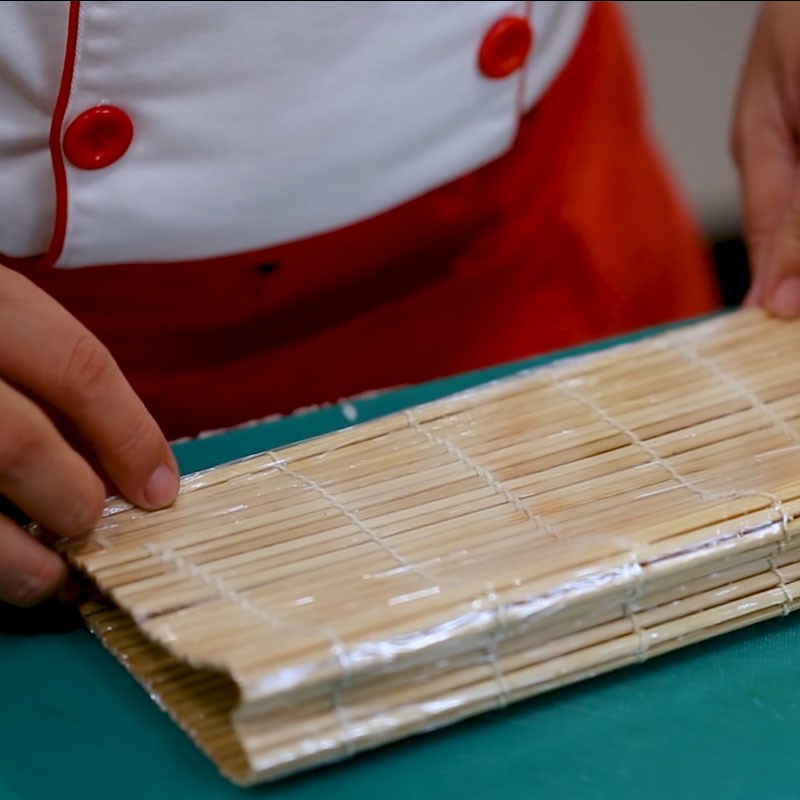
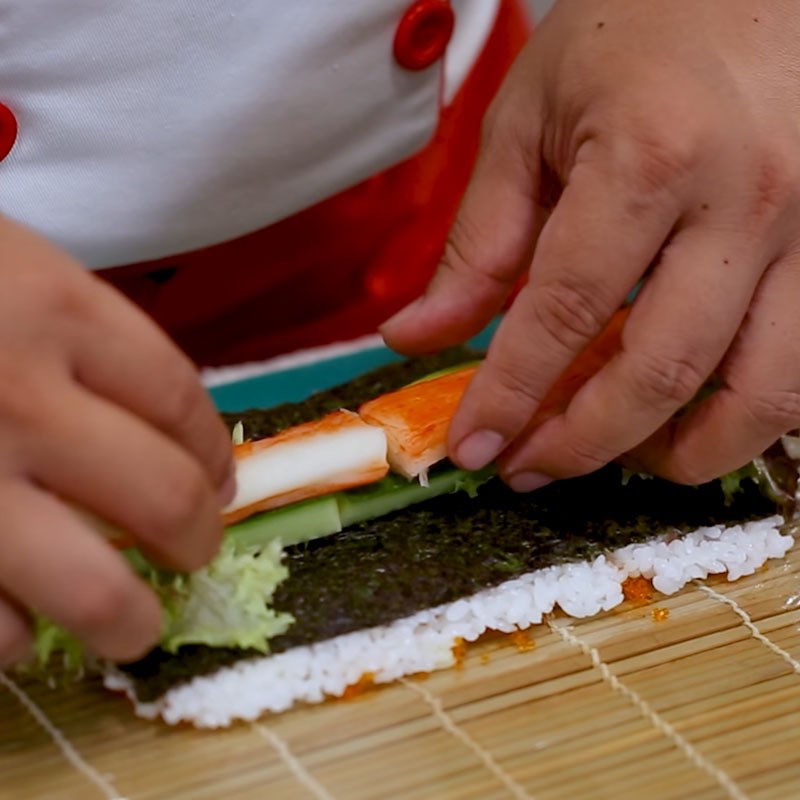
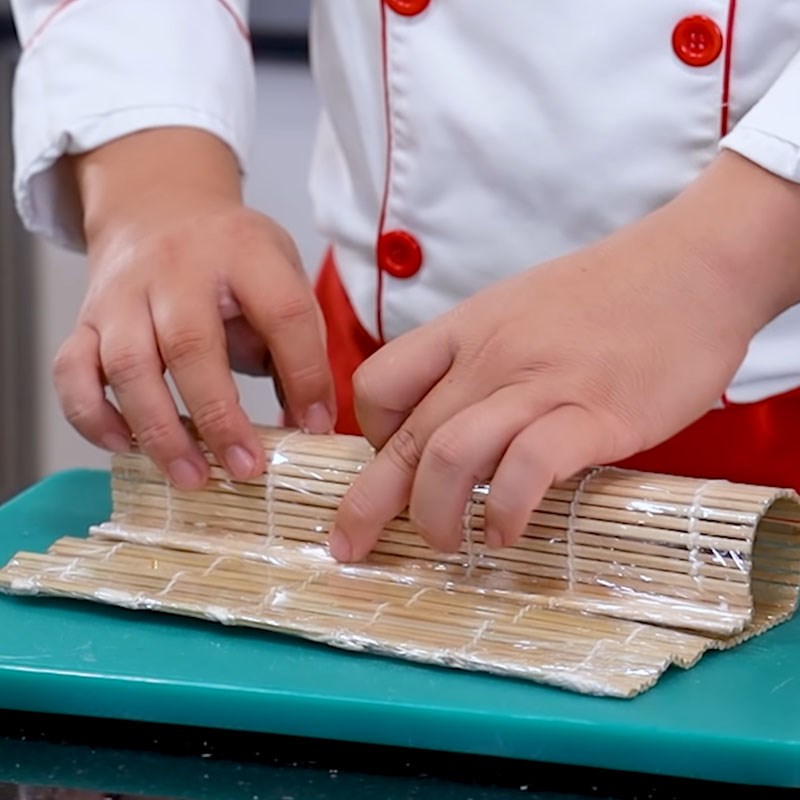
-
Completion
After rolling the rice, use a damp cloth to wipe the knife evenly and cut the sushi roll into small bite-sized pieces about 1 – 2 cm thick.
Tip: Wiping the knife with a damp cloth before cutting sushi helps prevent the knife from sticking to the rice and avoids crushing the sushi roll.
Serve the sushi on a plate, drizzle a little mayonnaise sauce on top, arrange with some pickled pink sushi ginger on the side, and decorate it nicely to complete.
See more:

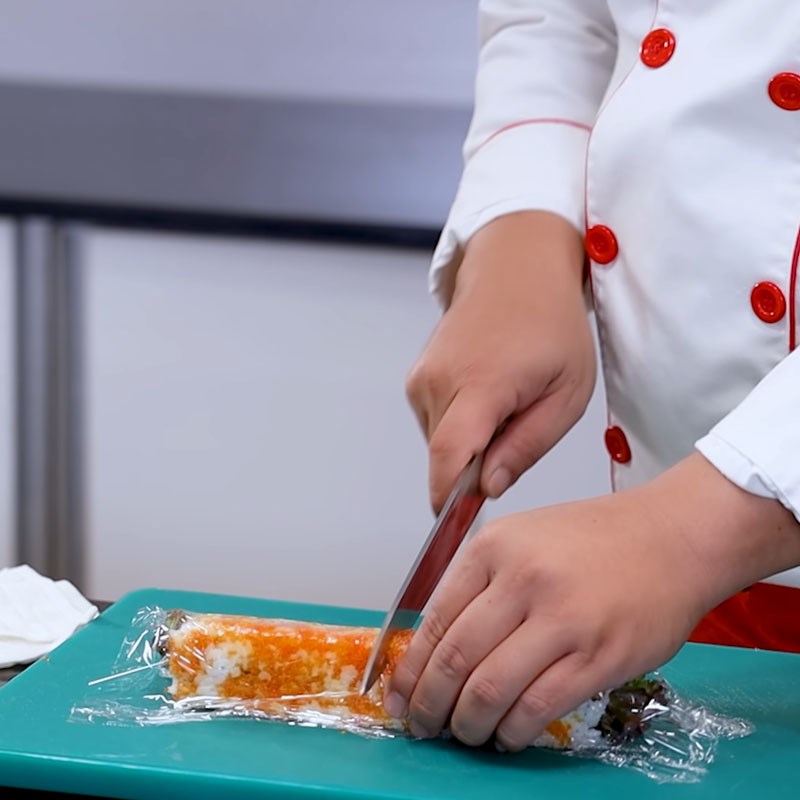
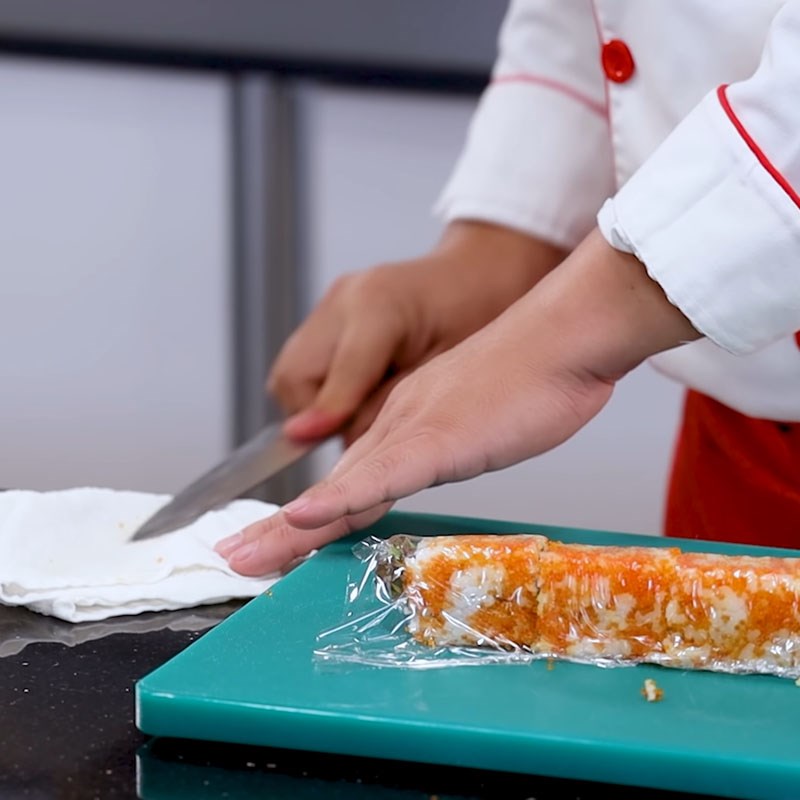
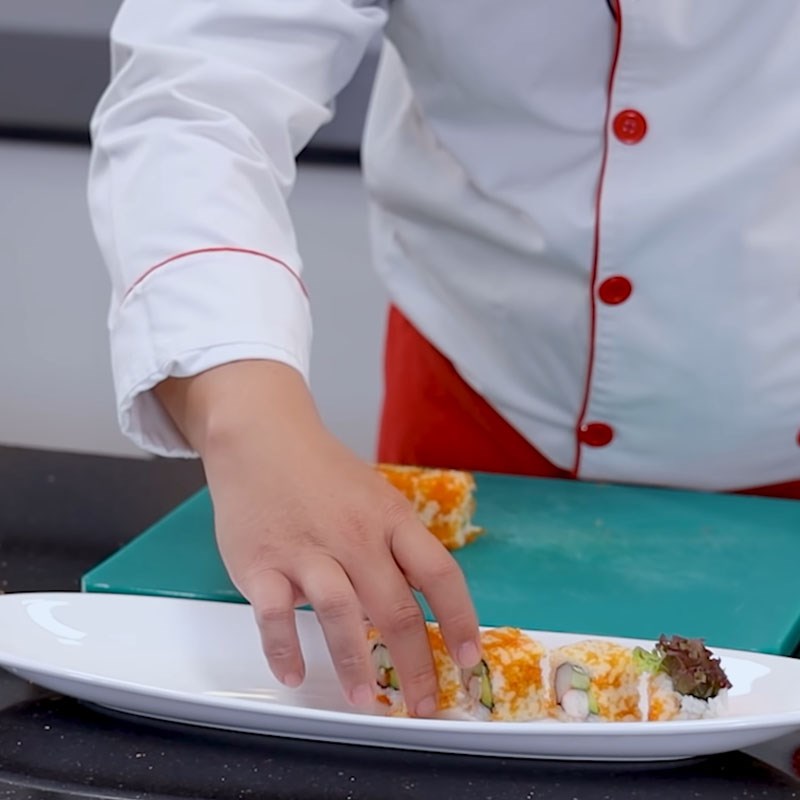
-
Final product
So the delicious Maki Sushi has been completed with very eye-catching colors and an enticing flavor. The rice is soft and sticky, and the filling of vegetables, shrimp, and crab sticks is crispy and sweet, stimulating the taste buds immensely. What are you waiting for? Hurry into the kitchen and make this dish for the whole family to enjoy!
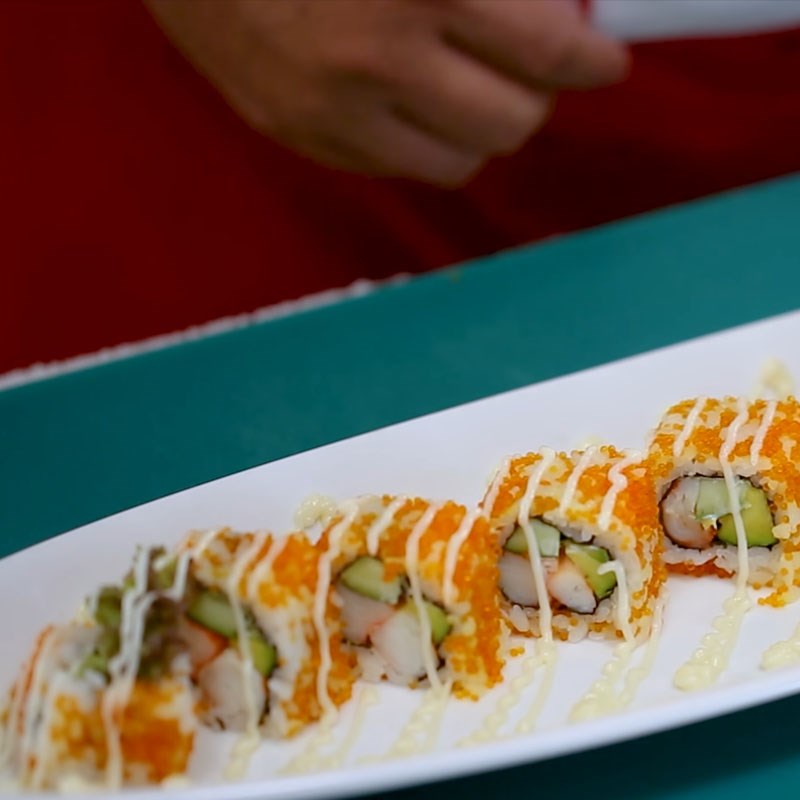
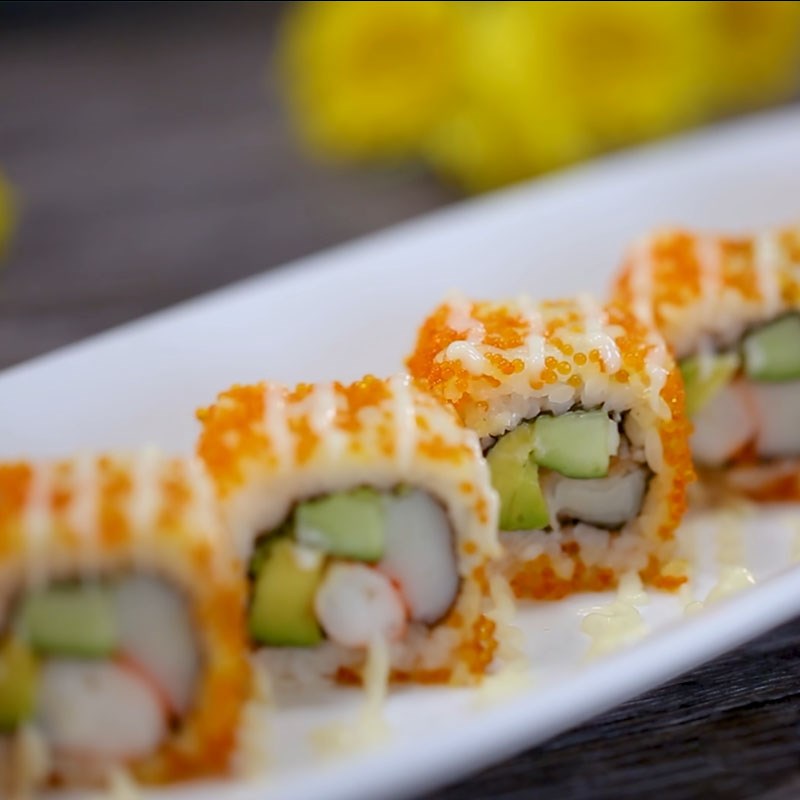
Successful execution tips:
- Sushi can be dipped in soy sauce mixed with a little wasabi or chili sauce mixed with mayonnaise.
- To enhance the appeal of the dish, you can serve it with some pickled white radish or sweet and sour pink ginger.
- Besides the fillings introduced in the article, you can substitute shrimp and flying fish roe with tuna, salmon, scallops,…
See more:
Some notes when using sushi:
- Although sushi is a nutritious dish, you should not eat too much, especially when using fresh seafood like salmon, tuna,… as filling.
- Some studies show that in raw salmon, tuna,… there is a high content of protein, fat, and salt. People who are allergic or have weak constitutions may not be able to digest it quickly if they eat too much, which can easily cause vomiting, bloating, diarrhea, and many other digestive disorders.
- Additionally, raw fish and seafood contain a significant amount of bacteria and parasites, which, if not processed and stored properly, can negatively affect health.
See more:
Just now, here is how to make Maki sushi delicious and simple at home that TasteVN shared with you, try it out to make family meals even more appealing, wish you success.
*Refer to images and recipes from the YouTube channel Cooking Skills
